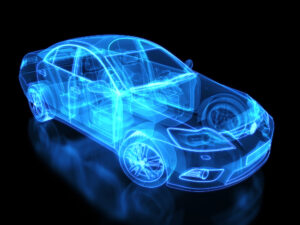
Automaker panel shares tips, potential future benefits of telematics
By onAnnouncements
Collision managers from Mercedes-Benz and Rivian recently shared telematics tips for collision repairers working on connected vehicles, ranging from the importance of a good Wi-Fi signal to ensuring software updates have been made to replacement parts.
Benito Cid, collision manager at Mercedes-Benz USA, discussed current and possible future use cases for telematics during a Collision Industry Conference (CIC) seminar that also featured Kelly Logan, Rivian’s collision repair director.
Speaking to attendees last week in Indianapolis, Indiana, Logan said Rivian’s growing service network is able to use data from its electric vehicles (EVs) to remotely get a head start on maintenance or repairs.
“When a customer calls in and has an issue, [service centers] create a work order,” he said. “Before that vehicle comes in, the vehicle is being looked at by a repair planner on the service side. They’re looking at logs; they’re looking to see if they can identify any problem with the vehicle before it shows up so they can actually have a good plan of what to do.”

When asked whether telematics will eventually allow vehicles to order their own parts following a collision, Logan said it’s possible.
“I think that’s the ultimate goal,” he said. “If you think about the future, and the connected vehicle and where we can go and where everybody wants to be, it is a [situation where] a vehicle gets into an accident and basically creates a parts list that it then sends to the OE.”
However, Logan noted that such a scenario is years away from reality and that plenty of data would need to be collected beforehand. He also questioned whether a vehicle capable of generating its own parts list post-accident would be submitting accurate information.
“If a vehicle gets into an accident, and it shows that the headlights are bad after the accident, is the headlight bad? Or did the wiring harness get damaged in the accident and there’s nothing actually wrong with the headlight?” Logan said. “It’s going to take a long time to get that accuracy.”
Cid wasn’t as optimistic about a future where vehicles produce their own parts lists but said it’s more likely that vehicles eventually start sharing information that helps repair shops triage vehicles.
He said technology could alert a repairer to the severity of an accident, where it’s damaged, and whether it’s drivable.
“You could potentially start putting together some idea of what it’s going to need on the repair, but again, it’s not a blueprint,” Cid said. “It’s not even an estimate. You’re basically getting a really basic list of what the car could potentially need. It may be good for an initial parts order but for sure for triaging, it’s a good start.”
Kelly said that in the here and now, one tip for repairers is to ensure the parts they’re installing in connected cars are equipped with the latest software updates.
He gave an example of a control module that might have unknowingly been sitting in a warehouse for six months before being installed in a car during repairs.
“From Rivian’s perspective, when the technician installs that and hooked it up to our diagnostic tool, that module needs to be brought up to the current software,” Kelly said. “Sometimes it’s as easy as using the diagnostic tool but in some instances we may have to make and send a custom over-the-air update to flash that particular module.”
Kelly said such a scenario underscores the importance of shops having strong Wi-Fi signals, as they’ve become an important part of making sure vehicles are repaired quickly.
Cid agreed and recommended that any time a shop works on a vehicle, technicians should make it a habit to check whether software updates need to be complete.
“Obviously, if the customer gets it back and it needs an update that it didn’t show it needed before the accident, of course it’s related and it just adds to problems or concerns when it’s realistically something that normally can be taken care of pretty quickly through over-the-air updates,” Cid said. “Other areas you want to keep in mind beyond the straightening of the metal is [ensuring the vehicle is] going back to the customer up-to-date.”
Both Cid and Logan also touched on how to approach vehicles that customers continue to have remote access to during repairs.
Logan said shops can disable the features on some cars while work is underway or temporarily put it into service mode to prevent owners from toying with the functions during repairs.
“It’s not about disconnecting the customer from their vehicle but in certain instances, you can open doors, you can open a hood, you can honk the horn,” Logan said. “I know of probably two instances where there was a car and a paint booth and someone decided to open a hood that was all masked off, or was painted, and ruined that paint job. These are real instances.”
Logan added: “If you’re a technician working on the front end of a car and all of a sudden the horn blares, you’re really not going to be too happy about that.”
Cid said it’s important for shops to document when they put a vehicle in service mode and when it exits service mode for customer awareness.
“It’s just one of those QC checks,” he said.
Images
Featured image: iStock/Henrik5000
Secondary image: Benito Cid of Mercedes-Benz (left) and Kelly Logan of Rivian (right) speak during a Collision Industry Conference seminar in Indianapolis, Indiana on July 18, 2023. (Michelle Thompson/Repairer Driven News)
